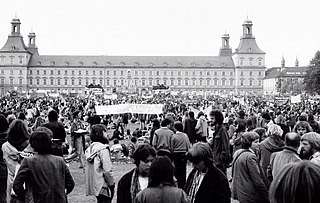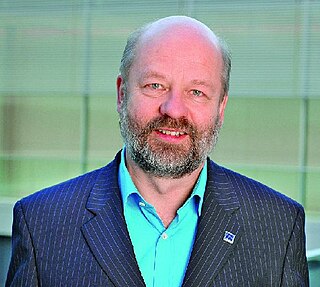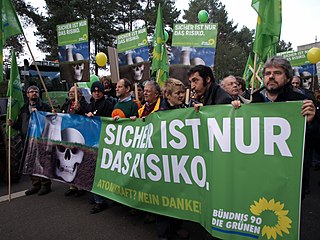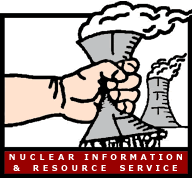
The anti-nuclear movement is a social movement that opposes various nuclear technologies. Some direct action groups, environmental movements, and professional organisations have identified themselves with the movement at the local, national, or international level. Major anti-nuclear groups include Campaign for Nuclear Disarmament, Friends of the Earth, Greenpeace, International Physicians for the Prevention of Nuclear War, Peace Action and the Nuclear Information and Resource Service. The initial objective of the movement was nuclear disarmament, though since the late 1960s opposition has included the use of nuclear power. Many anti-nuclear groups oppose both nuclear power and nuclear weapons. The formation of green parties in the 1970s and 1980s was often a direct result of anti-nuclear politics.
The Koeberg Alert alliance is an anti-nuclear activist organisation which emerged from an earlier pressure group in Cape Town called "Stop Koeberg" in 1983. Both were intended to halt construction of the first nuclear power station in South Africa at Duynefontein, 28 km NNW of Cape Town: the Koeberg Nuclear Power Station.

Wyhl is a municipality in the district of Emmendingen in Baden-Württemberg in southwestern Germany.

The anti-nuclear movement in the United States consists of more than 80 anti-nuclear groups that oppose nuclear power, nuclear weapons, and/or uranium mining. These have included the Abalone Alliance, Clamshell Alliance, Committee for Nuclear Responsibility, Nevada Desert Experience, Nuclear Information and Resource Service, Physicians for Social Responsibility, Plowshares Movement, Women Strike for Peace, and Women's International League for Peace and Freedom. Some fringe aspects of the anti-nuclear movement have delayed construction or halted commitments to build some new nuclear plants, and have pressured the Nuclear Regulatory Commission to enforce and strengthen the safety regulations for nuclear power plants. Most groups in the movement focus on nuclear weapons.

Hermann Scheer was a Social Democrat member of the German Bundestag (parliament), President of Eurosolar and General Chairman of the World Council for Renewable Energy. In 1999, Scheer was awarded the Right Livelihood Award for his "indefatigable work for the promotion of solar energy worldwide".

Hans-Josef Fell was a member of the German Parliamentary Group Alliance 90/ the Greens from 1998 to 2013. He served as spokesman on energy for the Alliance 90/The Greens parliamentary group, a member of the Environmental Protection Committee, substitute member of the Committee on Economics and Technology and substitute member of the Defence Committee. Together with Hermann Scheer, he authored the 2000 draft of the Renewable Energy Sources Act, establishing the foundation for the technology developments in photovoltaic, biogas, wind power and geothermal energy in Germany. Fell is founder and president of the Energy Watch Group and an internationally renowned energy and climate change advisor, author and speaker.

Nuclear weapons testing, uranium mining and export, and nuclear power have often been the subject of public debate in Australia, and the anti-nuclear movement in Australia has a long history. Its origins date back to the 1972–1973 debate over French nuclear testing in the Pacific and the 1976–1977 debate about uranium mining in Australia.

The anti-nuclear movement in Germany has a long history dating back to the early 1970s when large demonstrations prevented the construction of a nuclear plant at Wyhl. The Wyhl protests were an example of a local community challenging the nuclear industry through a strategy of direct action and civil disobedience. Police were accused of using unnecessarily violent means. Anti-nuclear success at Wyhl inspired nuclear opposition throughout Germany, in other parts of Europe, and in North America. A few years later protests raised against the NATO Double-Track Decision in Germany and were followed by the foundation of the Green party.
The 1970s proved to be a pivotal period for the anti-nuclear movement in California. Opposition to nuclear power in California coincided with the growth of the country's environmental movement. Opposition to nuclear power increased when President Richard Nixon called for the construction of 1000 nuclear plants by the year 2000.
Anti-nuclear organizations may oppose uranium mining, nuclear power, and/or nuclear weapons. Anti-nuclear groups have undertaken public protests and acts of civil disobedience which have included occupations of nuclear plant sites. Some of the most influential groups in the anti-nuclear movement have had members who were elite scientists, including several Nobel Laureates and many nuclear physicists.

In the 1970s, an anti-nuclear movement in France, consisting of citizens' groups and political action committees, emerged. Between 1975 and 1977, some 175,000 people protested against nuclear power in ten demonstrations.

The anti-nuclear movement in Kazakhstan, "Nevada Semipalatinsk", was formed in 1989 and was one of the first major anti-nuclear movements in the former Soviet Union. It was led by author Olzhas Suleimenov and attracted thousands of people to its protests and campaigns which eventually led to the closure of the nuclear test site at Semipalatinsk in north-east Kazakhstan in 1991. The movement was named "Nevada Semipalatinsk" in order to show solidarity with similar movement in the west of the United States aiming to close the Nevada Test Site.

More than 80 anti-nuclear groups are operating, or have operated, in the United States. These include Abalone Alliance, Clamshell Alliance, Greenpeace USA, Institute for Energy and Environmental Research, Musicians United for Safe Energy, Nevada Desert Experience, Nuclear Control Institute, Nuclear Information and Resource Service, Public Citizen Energy Program, Shad Alliance, and the Sierra Club. These are direct action, environmental, health, and public interest organizations who oppose nuclear weapons and/or nuclear power. In 1992, the chairman of the Nuclear Regulatory Commission said that "his agency had been pushed in the right direction on safety issues because of the pleas and protests of nuclear watchdog groups".

Anti-nuclear protests began on a small scale in the U.S. as early as 1946 in response to Operation Crossroads. Large scale anti-nuclear protests first emerged in the mid-1950s in Japan in the wake of the March 1954 Lucky Dragon Incident. August 1955 saw the first meeting of the World Conference against Atomic and Hydrogen Bombs, which had around 3,000 participants from Japan and other nations. Protests began in Britain in the late 1950s and early 1960s. In the United Kingdom, the first Aldermaston March, organised by the Campaign for Nuclear Disarmament, took place in 1958. In 1961, at the height of the Cold War, about 50,000 women brought together by Women Strike for Peace marched in 60 cities in the United States to demonstrate against nuclear weapons. In 1964, Peace Marches in several Australian capital cities featured "Ban the Bomb" placards.

Rolf Disch is a German architect, solar energy pioneer and environmental activist. Born in Freiburg im Breisgau, Germany, Disch has dedicated particular focus to regional renewable and sustainable energy.
Ursula Sladek owns a small local power company, Schönau Power Supply, located in Schönau im Schwarzwald, Germany, that provides electricity from renewable energy sources to the German electricity grid. Her company "gets much of its energy from small local energy producers, including a handful of hydropower operations, solar panels, some wind turbines, and about 20 washing-machine-size co-generation plants in people’s homes that produce both heat for the home and electricity for the grid". Sladek has also been interested in finding ways of rendering nuclear power unnecessary in Germany: Sladek won a Goldman Environmental Prize in 2011.
The anti-nuclear movement in South Korea consists of environmental groups, religious groups, unions, co-ops, and professional associations. In December 2011, protesters demonstrated in Seoul and other areas after the government announced it had picked sites for two new nuclear plants.

Long one of the world's most committed promoters of civilian nuclear power, Japan's nuclear industry was not hit as hard by the effects of the 1979 Three Mile Island accident (USA) or the 1986 Chernobyl disaster (USSR) as some other countries. Construction of new plants continued to be strong through the 1980s and into the 1990s. However, starting in the mid-1990s there were several nuclear related accidents and cover-ups in Japan that eroded public perception of the industry, resulting in protests and resistance to new plants. These accidents included the Tokaimura nuclear accident, the Mihama steam explosion, cover-ups after accidents at the Monju reactor, and the 21 month shut down of the Kashiwazaki-Kariwa Nuclear Power Plant following an earthquake in 2007. Because of these events, Japan's nuclear industry has been scrutinized by the general public of the country.

Anti-nuclear protests in the United States have occurred since the development of nuclear power plants in the United States. Examples include Clamshell Alliance protests at Seabrook Station Nuclear Power Plant, Abalone Alliance protests at Diablo Canyon Power Plant, and those following the Three Mile Island accident in 1979.














